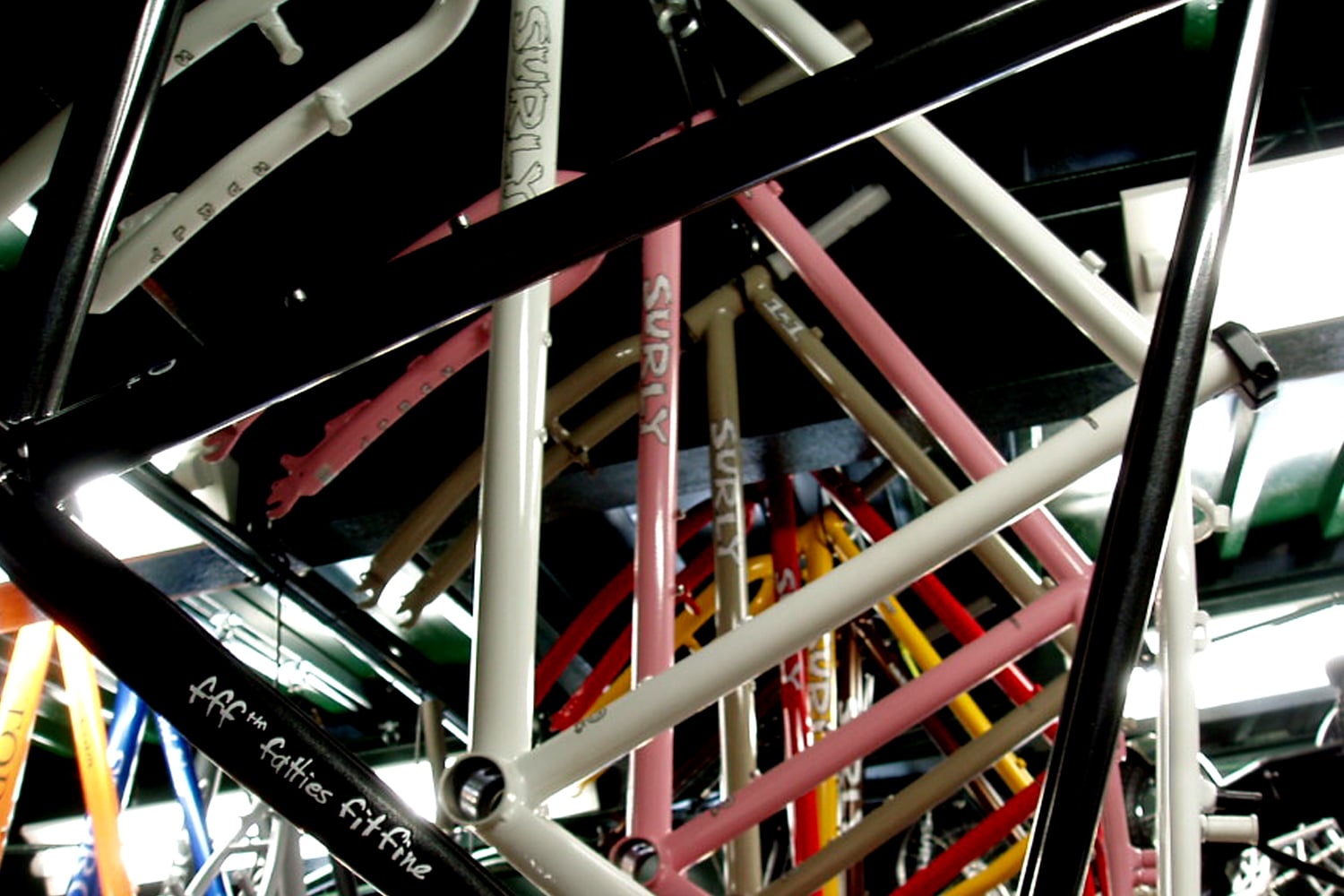What length bottom bracket (BB) spindle do we recommend for your new Surly? We don't. Spindle length is determined mainly by what the manufacturer of your crank recommends. If this information was not supplied with your crank, look it up on the net or give your local bike shop a call. If given two recommended lengths, consider these other variables:
Seat tube size- larger diameter (31.8mm and up, like the Instigator) seat tubes position the front derailleur farther from the center of your frame. Your chainrings must also be farther out to achieve good shifting. Having a larger diameter seat tube usually means opting for the longer of the two recommended spindle lengths. All other Surly frames have 28.6mm outside diameter seat tubes.
Massive chainrings- if you're using big chainrings, say a 50 tooth, you may need a longer spindle to clear the chainstays. In most other cases, the shorter BB spindle will work on your bike. This doesn't mean you can just use any size ring by installing a longer BB spindle. For one thing modern outboard bearing BBs are not usually offered in multiple spindle lengths, and even if you're using a square taper style BB the longer spindle may put the ring far outboard of the hub's chainline and you can't adjust that much if at all.
Other crap about drivetrains:
Chainline on singlespeeds- What is chainline? It's the distance from the center of the frame to the front ring and/or the center of your rear dropouts to the cog. The chain should run in a straight line from the front ring to the rear cog within a couple millimeters. If it doesn't, you're gonna have a McDirtwich for lunch. You'll want the front chainring and crank arm fairly close to the chainstay, but not so close that you start rubbing metal-on-metal when your frame flexes.
What rear hub are you using? Most single speed specific hubs, like the Surly New hubs, put your cog into a nice position outwards from the center of the dropouts (approximately 53.5mm for MTB, 42.5mm for track). If using a cassette-style hub, space the cog close to the frame. This should be a good starting point for chainline adjustments.
Avoid using old multi-speed freewheel hubs for single speed drivetrains. These put the cog so far inwards you won't be able to achieve good chainline. Not to mention you'll have a long chunk of axle sticking out between the bearing and the frame just waiting to get bent. Who cares if your 1991 Mavic hub is still smooth like mayonnaise? It won't cut the mustard.
Example for the sake of giving you an example: I once set up a 1x1 frame with a Truvativ Stylo SS crank and a Surly New hub (fine products). Truvativ recommended a 113mm BB spindle. After installing a FSA Ultimax Extreme (fine product), 73 x 113mm BB, the front chainline was shorter than the rear chainline Or rather, as I looked at the drivetrain from the rear end of the bike to the front, the chain traveled inward towards the center of the frame at the BB. In order to place the front chainring outwards I could:
Option #1: move the front chainring to the outside crank spider arm position which included repositioning the fine Truvativ bash guard with chainring spacers and longer chainring bolts.
-OR-
Option #2: place a spacer between the bottom bracket and the frame on the driveside.
-OR-
Option #3: install a 118mm spindle.
In this case, all options worked quite well to correct the chainline. The chainring and crankarms had a sufficient gap between the frame as well.
Chainline on multi-geared bikes is measured from the center of the frame to the middle chainring on a triple crank, center of frame to midway between chainrings on a double crank, and/or the center of your rear dropouts to the middle of the cogs/cassette. Shifting into these middle gears will allow you to eyeball how straight the chain is.
Chainline adjustments on any bike are done by re-spacing your hub, adding or deleting freewheel spacers, moving a single cog between cassette spacers, changing cranks, using spacers between the crank spider and the chainring, moving the chainring to inside/outside crank spider position, changing BB spindle length or just putting a spacer on the BB cup. When in doubt, consult your friendly local bike mechanic so they can check your equipment out and recommend the best spindle length.
Bottom bracket shell width is literally the distance of your BB shell width.
- 68mm Surly BB shells: Crosscheck, Travelers Check, Steamroller, Pacer, Big Dummy, and Long Haul Trucker.
- 73mm Surly BB shells: 1x1, Instigator, and Karate Monkey.
- 100mm Surly BB shells: Pugsley
Hey, since we can't see your bike set up, we cannot pinpoint the exact BB spindle size you'll need. Each bike is different and requires hands-on examination. This is what your local mechanic is for.
Remember not to freak out about your bike. It's just a bike and it's designed to give you pleasure.
Nick
 Surly Bikes
Surly Bikes